Introduction:
I have written this paper as an introduction to the use of Completely in the Canal (CIC) instruments for transcranial CROS fittings. It is intended as a set of guidelines for clinicians who have had little or no exposure to this technique. In other words, just about everybody. I am using information from a series of lectures that I gave on this topic in Canada a couple of years ago. It is an extension of an article that appeared in the Journal of the American Academy of Audiology (Hayes & Chen, 1998). That paper consisted of three successful cases where this approach was used. This is more of a nuts and bolts description of the technique.
Normal Candidacy:
1) One completely dead ear - no measurable hearing in that ear.
2) One ear at or near the normal range - air conduction thresholds of 25 dBHL or better.
3) A large enough and straight enough ear canal in the dead ear so that the second bend can easily be visualized with an otoscope.
a. Ideally the canal will be round or slightly oval shaped.
b. Some curvature will be essential to hold the aid in place so an unusually straight canal can be as bad as a narrow or sharply bent canal.
4) People who need to improve their performance in moderately noisy and sometimes quite noisy situations. This is where the transcranial fittings shine compared to standard CROS fittings (explained below).
5) Motivation is key for your client and you. You may have to take more than one impression to make this work.
The Problem:
A CROS hearing aid is used in cases where a person has no aidable hearing on one side of their head and relatively normal hearing on the other side. As you know the purpose of the CROS fitting is to pick up an acoustic signal from the side of the head with no useable hearing and apply that signal to the (normal) ear on the opposite side of the head. The primary goal of such a fitting is to improve audibility for soft signals, particularly in the higher frequency range, coming from the side of the "dead" ear. This should be done without necessarily amplifying those signals. The CROS aid in such a case eliminates the head shadow effect and may improve sound localization to a limited extent.
The main problem with any transcranial CROS fitting is one of power: i.e., how do you get enough power from the "dead ear" to the good ear? The short answer is that about 50% of the time you will not. In my experience, and that of others with whom I have spoken, you may get your success rate up to 65% or even 70% if you persevere. Don't be discouraged; these fittings are difficult. Always remember you are fitting someone who is very likely to be unsuccessful with anything else. In my opinion 50% success versus 0% is pretty reasonable.
In a standard CROS fitting the goal is to route the signal from the dead ear around the head to the normal ear. Lack of power is not a problem because you are putting an amplified signal into a normal hearing ear. In fact, too much power is the most typical problem. People find their CROS aids quite acceptable in very quiet situations. However, people with one normal ear do not typically complain of trouble in quiet situations. The difficulty begins when directional hearing is required or when there is moderate background noise. Standard CROS fittings work pretty well for directional hearing but even moderate background noise will often cause the user to reject the aid. Remember an amplified signal is being routed to a normal ear. Good compression and a comfortable MPO setting are absolutely essential to avoid rejection but that is still often not enough. For a better perspective on the problem please see Figure 1.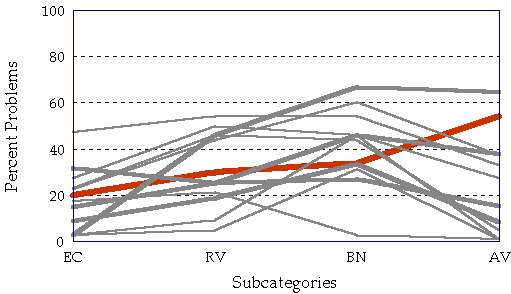
Figure 1. APHAB scores for 11 persons with unilateral loss.
The gray lines in Figure 1 show the Abbreviated Profile of Hearing Aid Benefit (APHAB) scores for 11 people with total unilateral hearing loss. Each line represents the unaided scores for one person. I have graphed the percentage of problems that each person reported on four subscales; EC - mainly quiet, RV - reverberation, BN - background noise and AV - aversion to loud sounds. A lower score indicates fewer reported problems. The red line shows the 95th percentile of scores for unaided bilaterally normal hearing individuals (Cox, 1995; Cox, 1997). In other words, 95% of normal hearing individuals score below the red line at each subscale. Note the considerable range of scores I found for all four subscales. Even in the EC (quiet) situations there is considerable variability amongst a group of people with one normal ear. It would be a mistake to assume that all these people experience similar problems and require similar types of remediation simply because they all have the same audiogram.
In Figure 2 below we see what happened to their scores after one month of wearing a CROS hearing aid.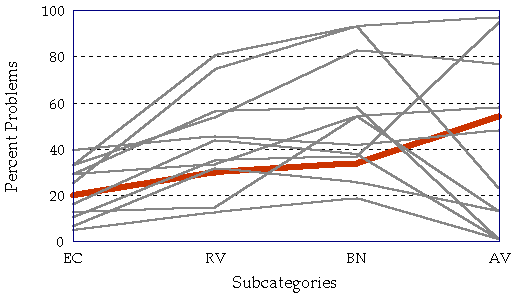
Figure 2. APHAB scores for 11 persons with unilateral loss after 1 montth of wearing a CROS aid.
When you compare the unaided scores in Figure 1 to the aided score in Figure 2 there is not much change in quiet (EC) but in RV and BN there is a wider range of scores in the aided condition. So a few people did much worse and a few did a bit better in reverberation and background noise. As a whole the group scores got worse when CROS aids were worn. The aversion subscale (AV) in Figure 2 also demonstrates quite a bit of variability. Five people reported considerable problems with aversion but the other six had reported very low AV scores.
In Figure 3 we have the scores of 7 successful CROS aid wearers.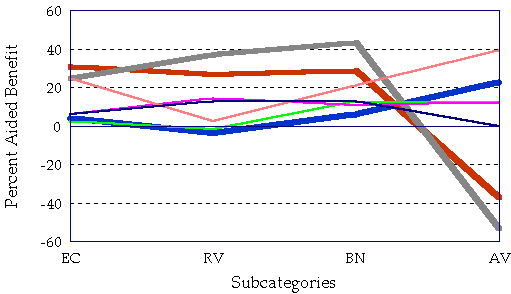
Figure 3. APHAB benefit scores for 7 successful CROS aid wearers.
This Figure is showing Aided Benefit scores. They are obtained by subtracting an individual's aided problems score from the unaided problems score (Cox, 1995; Cox, 1997). It is assumed in most cases that wearing a hearing aid should reduce a person's perception of problems. Therefore, the amount of problem reduction caused by a hearing aid equals the amount of benefit due to the aid. So, in Figure 3 a higher score is a better score. The three thick lines represent successful wireless CROS fittings and the four thin lines represent successful transcranial CIC fittings. The transcranial fittings were from people who had already rejected standard CROS hearing aids. Please bear in mind, this is only 7 cases.
Notice that the greatest improvement in perceived benefit for EC, RV and BN resulted from the use of standard CROS hearing aids. Both of those people also reported a very significant problem with AV. They felt the CROS aid helped them hear better but it caused discomfort in noise. The other five people reported no problems with AV and they were happy with their CROS aids (1 wireless, 4 transcranial) even though they did not perceive as much listening benefit from them. The main point here is that when the standard CROS aid works it provides a lot more subjective benefit than the transcranial aid. But it may do so at a cost to comfort. Note how much worse the Aversion category is for the two best standard CROS aids. There is no such aversion for the transcranial CROS fittings but there is less of a perception of power and/or benefit. In fact, the aided benefit scores on the APHAB are only significant for three of the four and just barely, but they liked and kept the aids after rejecting others.
Achieving Success:
The real trick with these fittings is to take advantage of the vibrations from the hearing aid receiver. If you can get the receiver far enough down the ear canal to reach the temporal bone, and if the hearing aid makes physical contact with that bone, you will have obtained your first objective.
The Procedure is as Follows:
1) Clean the ear canal of debris as best you can.
2) Take a deep impression all the way to the second bend (Temporal bone).
a. This means, if possible, get a small otoblock, half as long as a normal otoblock, into the canal until the lateral face (the one you can see) is at or just past the second bend.
b. Always use silicone impression material.
c. Always take a mouth open impression with a bite block between the molars on the side of the impression. This is the best way to ensure that the anterior wall of the cartilaginous ear canal is pulled completely forward by the Temporal Mandibular Joint while the impression sets.
d. Upon removal you should have a full thick impression where you can see the direction of the second bend.
e. If it does not look right or long enough do it again, otherwise you will be returning the first hearing aid for credit or remake for sure.
3) Order an unvented, nontapered CIC whose medial end extends to the second bend of the canal. Make sure it has a shell you can see through.
4) Order the most powerful linear CIC you can get. Compression will not be necessary.
5) When you receive the hearing aid, look at it. If the receiver is mounted with silicone (to damp vibration and feedback) you may have problems. If the receiver is mounted closer to the faceplate than to the sound bore you may have problems. Try the aid with cautious optimism.
When you try the aid on your client they may have some difficulty getting it in their ear. That is common. It is one reason why a sharply bent ear canal may cause a failed fitting. When it is in place turn up the volume as high as possible until you get feedback or the user notices a difference. The difference is always subtle. They will have to wear the aid in situations where they personally are having difficulty to make a valid assessment of it.
To assess these fittings real-ear measurements are possible but not very easy. Furthermore, you want to know how much is crossing over to the other side of the head not the sound pressure in the ear with the aid. A more direct approach is to test the aided and unaided crossover thresholds using headphones. The procedure has been described in detail in Hayes & Chen (1998). In brief, crossover thresholds can be obtained by presenting a pure tone to the dead ear and increasing the intensity until your client responds. Obviously, you have overcome interaural attenuation and the signal has gotten loud enough for them to hear it in the working cochlea. Thus, it has crossed over. Actually the unaided crossover threshold isn't really necessary but it is useful for counseling the client about your goals. The main objective is to obtain the crossover thresholds with the aid in place.
The crossover thresholds you will most likely see are discussed below and shown in Figures 4 and 5. Figure 4 shows the crossover thresholds for 6 transcranial CROS fittings were the clients felt they benefited from the aids, used them frequently and decided to keep them. Figure 5 depicts the transcranial crossover thresholds from 4 individuals who were unsuccessful.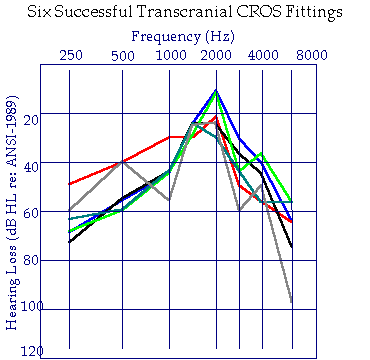
Figure 4. Transcranial crossover thresholds for 6 successful users.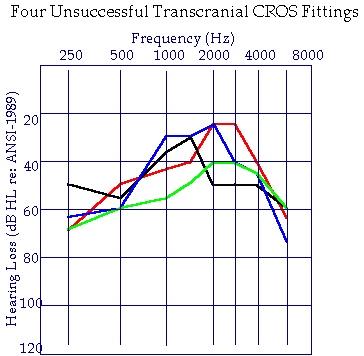
Figure 5. Transcranial crossover thresholds for 4 unsuccessful users.
These two figures serve to illustrate a few salient features of successful transcranial CROS fittings. I am defining success very subjectively as those individuals who perceived benefit and wore the hearing aids regularly after at least a one month trial period. In the unsuccessful fittings the aids were returned after one or more months of trial.
Features to Look for Include:
1) As you can see crossover thresholds are often very similar in Figures 4 & 5 but typically slightly better for successful fittings than for unsuccessful fittings.
2) Successful fittings will present with at least one threshold in or very near the normal range (25 dB HL). Often at 2000 Hz.
3) There is a peak resonant frequency that tends to occur in the 1500 - 2000 Hz range. The mechanical resonant frequency of both the hearing aid receivers and the temporal bone occurs in that range. The resonance may be due to one or both of them.
4) The better the mechanical connection of the hearing aid receiver to the temporal bone the better the peak. Increasing the success rate.
5) Even the best fitting provides very little crossover above 3000 Hz. This may explain why the wireless CROS provides more subjective benefit when the aversion to loud sounds is under control.
To summarize, if your client has crossover thresholds as good as those in Figure 4 you have probably done about all you can. If they are happy with the aid then there is not much more you need to do. If they are unhappy with it you will know that you have done all you can. It might be unrealistic for them to expect success with a transcranial CIC. Knowing this helps you to know when to quit and when the client's expectations may be unreasonable.
On the other hand, if their crossover thresholds are no better than those in Figure 6 you may still have some maneuvering room. Look at the hearing aid shell. Is it tapered? Is it too short? If so, then you can change that. Unfortunately this may require a new impression or a new manufacturer. Look at the receiver. Is it mounted with silicone? Have it removed. Is the receiver closer to the sound bore or the faceplate? If it is not close to the sound bore then have it moved closer. That may not sound like much but it does work, as illustrated in Figure 6.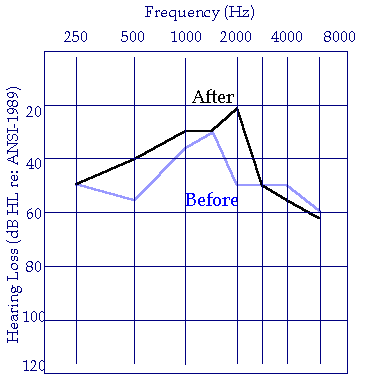
Figure 6. Transcranial crossover thresholds before and after an earmold remake.
This is the case of a man who was initially unsuccessful with his transcranial CIC. The shell of the aid was long and full. I felt that changing the impression could not improve the shell or the mechanical contact to the Temporal bone. His before thresholds are shown in blue in Figure 5. When I obtained those thresholds I noticed that the receiver was mounted close to the hearing aid faceplate. I asked to have it moved as close as possible to the sound bore (leaving everything else alone). When he returned I repeated the measurement and you can see his after thresholds are much better. The difference between the before and after crossover thresholds for this man came from moving the receiver a little further down the sound bore making better mechanical contact with the temporal bone. The additional bone conduction achieved an improvement of 25 dB of gain at 2000 Hz.
Key Points for Fitting Transcranial CROS:
1) Select motivated candidates. The fitting may take some trial and error and they should be committed to it.
2) Take a long, mouth open, silicone impression to the second bend.
3) Order an unvented, nontapered, powerful linear CIC with the receiver as close to the sound bore as possible.
4) The aided transcranial crossover thresholds under headphones should have a peak (1500-2000 Hz) at or near the normal range.
5) There should be some improvement on the APHAB questionnaire in all conditions except Aversion, which should not get worse. See Figure 3.
6) These are difficult fittings at first. However they are worth trying since even limited success can improve your client's well being.
Final Note:
At one time I used this deep fitting, bone conduction technique for a woman who had bilateral otosclerosis. At the time she was unwilling to try anything else. She was amazingly successful. Her results are outlined in Hayes & Chen (1998). In fact, I had to use a less powerful hearing aid with compression than on any of the transcranial users.
I thought at the time that this would be an interesting path to follow with bone conduction amplification using CICs. Alas, I have not been able to get back to that since seeing her. I would be interested in following that up and in other people's experiences along that line, particularly if you have collected any hard data.
About the Author:
Donald Hayes M.S. was the Audiologist Consultant for many years at the Sunnybrook Health Sciences Centre in Toronto where this work was first completed. He was also a Lecturer for the University of Toronto during that time. He is currently finishing the Ph.D. program at the University of Cincinnati where he teaches hearing aid courses to the Audiology Master's students.
Works Cited:
Cox RM. (1995). The abbreviated profile of hearing aid benefit. Ear and Hearing, 16, 176-186.
Cox RM. (1997). Administration and application of the APHAB. The Hearing Journal. 50(4), 32, 35-36, 38, 40-41, 44-45, 48.
Hayes DE, Chen JM. (1998). Bone conduction amplification with Completely-in-the-Canal hearing aids. Journal American Academy Audiology. 9, 59-66.
Editor's Note:
This article originally appeared on www.audiologyjournal.com in April, 2000. Since that time, Audiology Online (www.audiologyonline.com) has acquired the Audiology Journal. This paper has been re-edited and updated and appears here as a courtesy to our readers for educational and informational purposes. We are grateful to the author and the Audiology Journal for allowing us (Audiology Online) to re-publish this updated version.
A Primer on CROS Fittings Using CICs
January 17, 2001
Related Courses
1
https://www.audiologyonline.com/audiology-ceus/course/auditory-wellness-what-clinicians-need-36608
Auditory Wellness: What Clinicians Need to Know
As most hearing care professionals know, the functional capabilities of individuals with hearing loss are defined by more than the audiogram. Many of these functional capabilities fall under the rubric, auditory wellness. This podcast will be a discussion between Brian Taylor of Signia and his guest, Barbara Weinstein, professor of audiology at City University of New York. They will outline the concept of auditory wellness, how it can be measured clinically and how properly fitted hearing aids have the potential to improve auditory wellness.
auditory
129
USD
Subscription
Unlimited COURSE Access for $129/year
OnlineOnly
AudiologyOnline
www.audiologyonline.com
Auditory Wellness: What Clinicians Need to Know
As most hearing care professionals know, the functional capabilities of individuals with hearing loss are defined by more than the audiogram. Many of these functional capabilities fall under the rubric, auditory wellness. This podcast will be a discussion between Brian Taylor of Signia and his guest, Barbara Weinstein, professor of audiology at City University of New York. They will outline the concept of auditory wellness, how it can be measured clinically and how properly fitted hearing aids have the potential to improve auditory wellness.
36608
Online
PT30M
Auditory Wellness: What Clinicians Need to Know
Presented by Brian Taylor, AuD, Barbara Weinstein, PhD
Course: #36608Level: Intermediate0.5 Hours
AAA/0.05 Intermediate; ACAud inc HAASA/0.5; AHIP/0.5; ASHA/0.05 Intermediate, Professional; BAA/0.5; CAA/0.5; Calif. SLPAB/0.5; IACET/0.1; IHS/0.5; Kansas, LTS-S0035/0.5; NZAS/1.0; SAC/0.5
As most hearing care professionals know, the functional capabilities of individuals with hearing loss are defined by more than the audiogram. Many of these functional capabilities fall under the rubric, auditory wellness. This podcast will be a discussion between Brian Taylor of Signia and his guest, Barbara Weinstein, professor of audiology at City University of New York. They will outline the concept of auditory wellness, how it can be measured clinically and how properly fitted hearing aids have the potential to improve auditory wellness.
2
https://www.audiologyonline.com/audiology-ceus/course/vanderbilt-audiology-journal-club-clinical-37376
Vanderbilt Audiology Journal Club: Clinical Insights from Recent Hearing Aid Research
This course will review new key journal articles on hearing aid technology and provide clinical implications for practicing audiologists.
auditory, textual, visual
129
USD
Subscription
Unlimited COURSE Access for $129/year
OnlineOnly
AudiologyOnline
www.audiologyonline.com
Vanderbilt Audiology Journal Club: Clinical Insights from Recent Hearing Aid Research
This course will review new key journal articles on hearing aid technology and provide clinical implications for practicing audiologists.
37376
Online
PT60M
Vanderbilt Audiology Journal Club: Clinical Insights from Recent Hearing Aid Research
Presented by Todd Ricketts, PhD, Erin Margaret Picou, AuD, PhD, H. Gustav Mueller, PhD
Course: #37376Level: Intermediate1 Hour
AAA/0.1 Intermediate; ACAud inc HAASA/1.0; AHIP/1.0; ASHA/0.1 Intermediate, Professional; BAA/1.0; CAA/1.0; Calif. SLPAB/1.0; IHS/1.0; Kansas, LTS-S0035/1.0; NZAS/1.0; SAC/1.0
This course will review new key journal articles on hearing aid technology and provide clinical implications for practicing audiologists.
3
https://www.audiologyonline.com/audiology-ceus/course/61-better-hearing-in-noise-38656
61% Better Hearing in Noise: The Roger Portfolio
Every patient wants to hear better in noise, whether it be celebrating over dinner with a group of friends or on a date with your significant other. Roger technology provides a significant improvement over normal-hearing ears, hearing aids, and cochlear implants to deliver excellent speech understanding.
auditory, textual, visual
129
USD
Subscription
Unlimited COURSE Access for $129/year
OnlineOnly
AudiologyOnline
www.audiologyonline.com
61% Better Hearing in Noise: The Roger Portfolio
Every patient wants to hear better in noise, whether it be celebrating over dinner with a group of friends or on a date with your significant other. Roger technology provides a significant improvement over normal-hearing ears, hearing aids, and cochlear implants to deliver excellent speech understanding.
38656
Online
PT60M
61% Better Hearing in Noise: The Roger Portfolio
Presented by Steve Hallenbeck
Course: #38656Level: Introductory1 Hour
AAA/0.1 Introductory; ACAud inc HAASA/1.0; AHIP/1.0; BAA/1.0; CAA/1.0; IACET/0.1; IHS/1.0; Kansas, LTS-S0035/1.0; NZAS/1.0; SAC/1.0
Every patient wants to hear better in noise, whether it be celebrating over dinner with a group of friends or on a date with your significant other. Roger technology provides a significant improvement over normal-hearing ears, hearing aids, and cochlear implants to deliver excellent speech understanding.
4
https://www.audiologyonline.com/audiology-ceus/course/easy-to-wear-hear-for-39936
Easy to Wear, Easy to Hear, Easy for You…Vivante
Your patients can benefit with a broader portfolio and range of style choices so they can choose the best model for their needs. We will review why Vivante is easy to wear, easy to hear, easy for you, focusing on sound performance, connectivity and personalization. Be ready to open up to a wide world of choice.
auditory, textual, visual
129
USD
Subscription
Unlimited COURSE Access for $129/year
OnlineOnly
AudiologyOnline
www.audiologyonline.com
Easy to Wear, Easy to Hear, Easy for You…Vivante
Your patients can benefit with a broader portfolio and range of style choices so they can choose the best model for their needs. We will review why Vivante is easy to wear, easy to hear, easy for you, focusing on sound performance, connectivity and personalization. Be ready to open up to a wide world of choice.
39936
Online
PT60M
Easy to Wear, Easy to Hear, Easy for You…Vivante
Presented by Kristina Petraitis, AuD, FAAA
Course: #39936Level: Intermediate1 Hour
AAA/0.1 Intermediate; ACAud inc HAASA/1.0; BAA/1.0; CAA/1.0; IACET/0.1; IHS/1.0; Kansas, LTS-S0035/1.0; NZAS/1.0; SAC/1.0
Your patients can benefit with a broader portfolio and range of style choices so they can choose the best model for their needs. We will review why Vivante is easy to wear, easy to hear, easy for you, focusing on sound performance, connectivity and personalization. Be ready to open up to a wide world of choice.
5
https://www.audiologyonline.com/audiology-ceus/course/real-ear-measurements-the-basics-40192
Real Ear Measurements: The Basics
Performing real-ear measures ensures patient audibility; therefore, it has long been considered a recommended best practice. The use of REM remains low due to reports that it can be time-consuming. This course will discuss the very basics of REMs.
auditory, textual, visual
129
USD
Subscription
Unlimited COURSE Access for $129/year
OnlineOnly
AudiologyOnline
www.audiologyonline.com
Real Ear Measurements: The Basics
Performing real-ear measures ensures patient audibility; therefore, it has long been considered a recommended best practice. The use of REM remains low due to reports that it can be time-consuming. This course will discuss the very basics of REMs.
40192
Online
PT30M
Real Ear Measurements: The Basics
Presented by Amanda Wolfe, AuD, CCC-A
Course: #40192Level: Introductory0.5 Hours
AAA/0.05 Introductory; ACAud inc HAASA/0.5; AHIP/0.5; ASHA/0.05 Introductory, Professional; BAA/0.5; CAA/0.5; IACET/0.1; IHS/0.5; Kansas, LTS-S0035/0.5; NZAS/1.0; SAC/0.5
Performing real-ear measures ensures patient audibility; therefore, it has long been considered a recommended best practice. The use of REM remains low due to reports that it can be time-consuming. This course will discuss the very basics of REMs.


